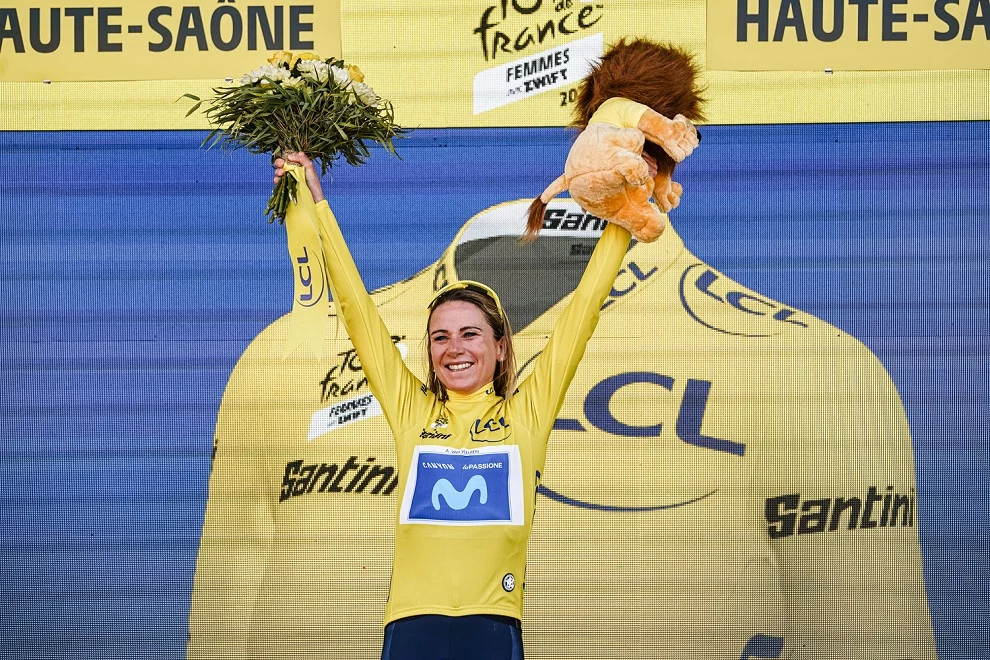When the Tour de France Femmes avec Zwift was reborn in 2022, there was no guarantee it would stick. Women’s cycling had long been fighting for attention, stability and respect, and many feared this revival would be another short-lived experiment. Four editions later, the race is not only surviving but has become the central pillar of a sport that now looks entirely different.
Back in 2021, the landscape was still uncertain. The Women’s WorldTour was growing, but many teams operated on modest budgets, and only a small number offered full-time salaries. The top riders were household names inside the sport but largely invisible outside of it. Live broadcasts were limited, often behind paywalls or not shown at all. Even the idea of a women’s Tour de France seemed remote – possible, maybe, but not promised.
Today, it’s hard to overstate how much has changed.
 Photo Credit: ASO-Thomas Maheux
Photo Credit: ASO-Thomas Maheux
From fragile foundations to financial security
The first and most striking shift has been financial. WorldTour team budgets have almost doubled in just four years, with the average now reaching €4.67 million, up from €2.35 million in 2022. That growth has fed directly into rider salaries, staffing, equipment and racing opportunities. More importantly, it has extended beyond just the top five teams. There is now meaningful depth across the peloton, both in results and in professional standards.
Minimum salaries, once a key sticking point, have improved across the board. Where riders used to cobble together part-time jobs or juggle studies, many now operate as full-time professionals with proper contracts, health cover and support structures. ProTeams are increasingly offering salaries too, a sign that the second tier is becoming a viable stepping stone rather than a financial dead end.
It’s a far cry from the situation pre-2022, where even WorldTour riders sometimes had to pay for their own off-season training camps.
 Photo Credit: Getty
Photo Credit: Getty
The race that changed everything
The Tour de France Femmes hasn’t just been a race; it’s become a shop window. In 2024, 80 million viewing hours were recorded across just seven key markets. It was broadcast in 190 countries, and in France alone, nearly 20 million tuned in. The visibility has done what years of lobbying and lobbying couldn’t: it’s made women’s cycling mainstream.
That attention has also driven participation. A recent Zwift-commissioned survey across four countries found that 85% of respondents now believe professional cycling is a realistic career option for women. That’s not just good for the top level – it’s helping to inspire investment at the base of the pyramid too, from development teams to school-level participation.
Strava data backs it up: women under 35 in the UK are now riding in greater numbers than ever, with a near 20% increase in activity uploads since 2019. Anecdotally, clubs across Europe are seeing more female members. The race is creating role models – and those role models are feeding the next generation.
 Photo Credit: Getty
Photo Credit: Getty
From domination to depth
The sport on the road has evolved too. The 2024 edition of the race was decided by just four seconds, the closest margin in the modern history of the event, and six different riders from five teams took stage wins. The predictability that once defined women’s cycling – where a select few dominated most races – has been replaced by genuine tactical variety and uncertainty.
Puck Pieterse, who won Flèche Wallonne this year, remarked recently that sprint lead-outs now look like men’s races – structured, drilled and tactical. Attacks come from deeper in the peloton, and races are often harder to control. That development is reflected in how teams approach stages now. There’s less waiting, more risk, and more riders capable of winning.
Technical skills have also become sharper. Anastasiya Kolesava pointed to the role descents and positioning now play, with time gaps just as likely to form on technical terrain as they are on final climbs. It’s not just about being strong – it’s about being complete.
 Photo Credit: Getty
Photo Credit: Getty
Beyond the peloton
The knock-on effects of the Tour’s rebirth are being felt across the industry. Social media engagement has more than doubled since 2022, with 74 million video views on official race content in 2024 alone. Sponsorship interest is rising. Nike joined the sport in 2024 through rider and team deals. Other global brands have followed.
Crucially, this isn’t just about ticking boxes. Brands are starting to see women’s cycling as a credible, valuable investment. The racing is compelling, the stories are authentic, and the numbers are increasingly hard to ignore.
But gaps remain. While Europe is well served by broadcast coverage, fans in North America still report poor access. The UCI calendar remains congested and uneven in quality. And while salaries have improved, there’s still a big difference between the best-funded and the rest. Visibility has grown, but that visibility now has to be sustained across the rest of the calendar – not just in one week in July.
What comes next?
As the 2025 edition begins, it feels less like a revival and more like an institution in the making. The Tour de France Femmes avec Zwift has gone from symbolic gesture to structural cornerstone. It has brought in new fans, changed the perception of what’s possible, and raised expectations across the board.
For a generation of riders now starting their careers, this is the new normal. Racing in front of millions. Wearing the yellow jersey in front of the Eiffel Tower. Getting paid properly to do it.
Four years ago, that was still a dream. Now, it’s just how things are.
